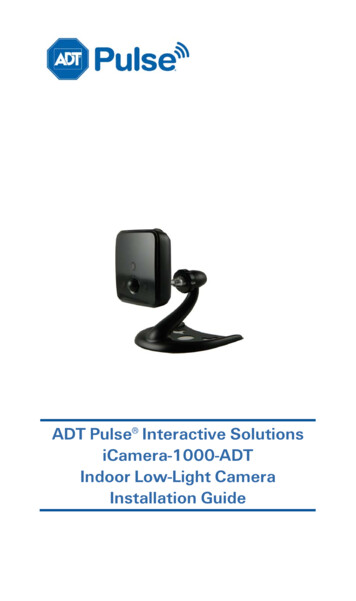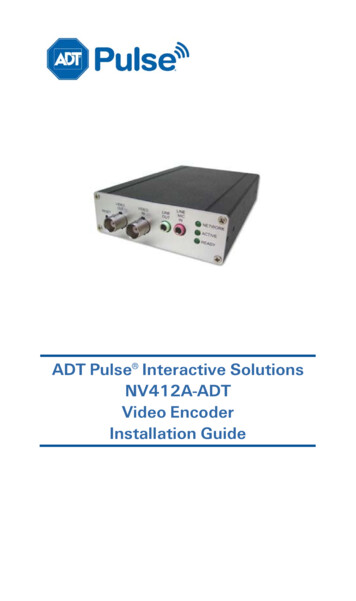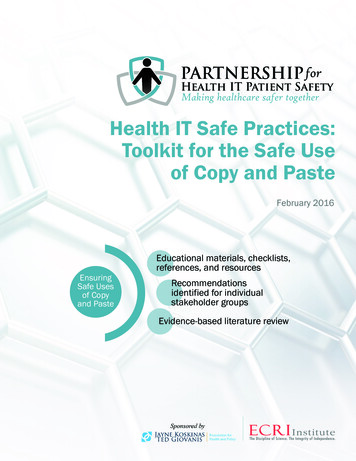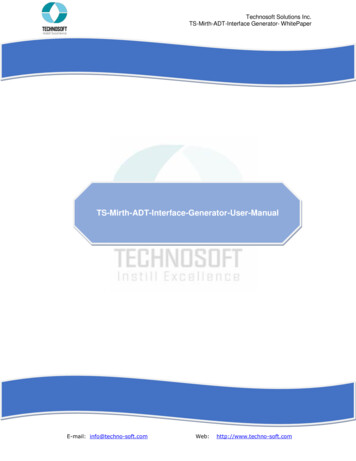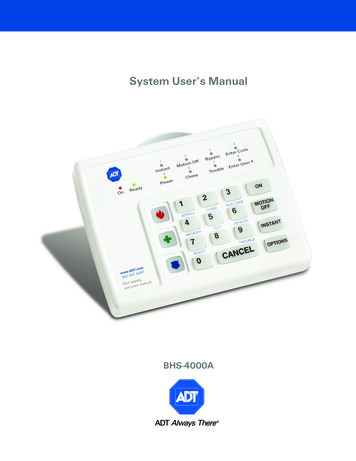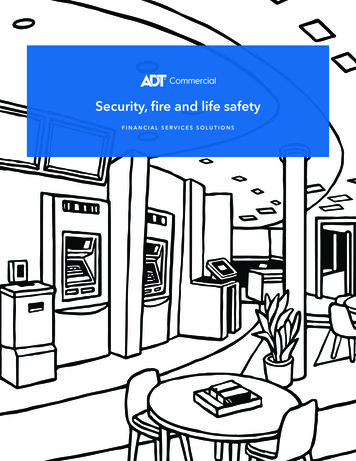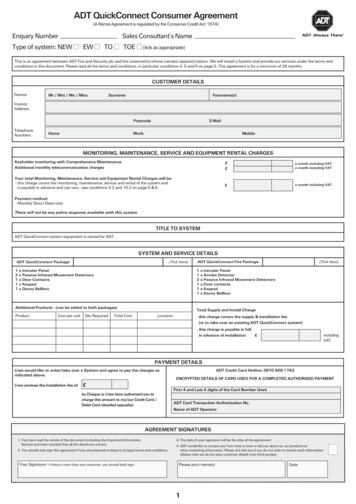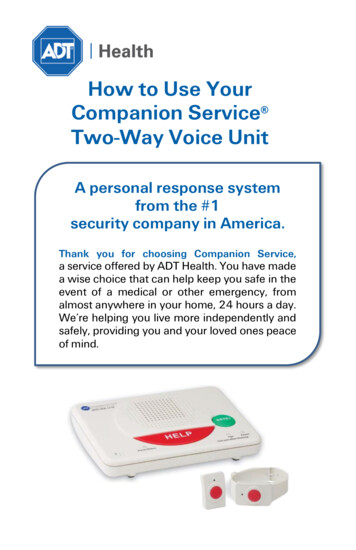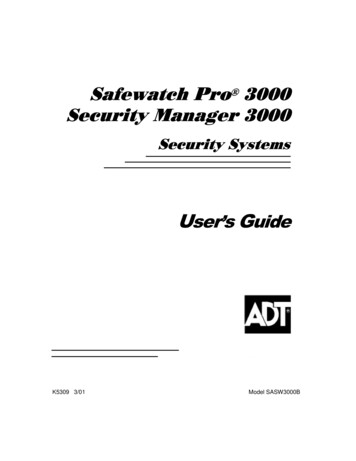
Transcription
SecuritySystemUser's ManualSafewatch Pro 2000ÊN7527–5V2 4/99Ref. 20ADTEG/20ADTEDUL File No. S1632
IMPORTANT!PROPER INTRUSION PROTECTIONFor proper intrusion coverage, sensors should be located at every possible point of entryto a home or commercial premises. This would include any skylights that may be present,and the upper windows in a multi-level building.In addition, we recommend that radio backup be used in a security system so that alarmsignals can still be sent to the Customer Care Center in the event that the telephone linesare out of order (alarm signals are normally sent over the phone lines).EARLY WARNING FIRE DETECTIONEarly warning fire detection is important in a home. Smoke and heat detectors have playeda key role in reducing fire deaths in the United States. With regard to the number andplacement of smoke/heat detectors, we subscribe to the recommendations contained in theNational Fire Protection Association's National Fire Alarm Code (NFPA 72). Theserecommendations can be found on page 34 of this manual.About This ManualThis manual is a step-by-step guide that will acquaint you with the system's features andbenefits. It defines the components and their functions, describes their operation, andprovides clear step-by-step instructions for normal and emergency procedures. Keep thismanual in a convenient place so that you can refer to it as necessary.Ð 2 Ð
TABLE OF CONTENTSSYSTEM OVERVIEW . 4General . 4A Partitioned System . 4Zones . 4Burglary Protection . 5Security Codes . 5Fire Protection . 5Alarms . 5Memory of Alarm . 6Phone Access & Voice Response Capability. 6Paging Feature . 6Single-Button Arming Feature . 6ENTRY/EXIT DELAYS . 7General Information . 7Exit Alarms . 8COMMON ZONE OPERATION. 8ABOUT THE TOUCHPADS . 9General . 92-Line Custom English Display Touchpads . 9English Display Touchpads . 9FUNCTIONS OF THE TOUCHPADS. 11CHECKING FOR OPEN ZONES . 13ARMING PERIMETER ONLY (STAY) . 14ARMING PERIMETER ONLY (INSTANT) . 15ARMING ALL PROTECTION (AWAY). 16DISARMING AND SILENCING ALARMS . 17BYPASSING PROTECTION ZONES . 18Quick Bypass. 19CHIME MODE .20PANIC KEYS .21SINGLE-BUTTON PAGING FEATURE .22USING DEVICE COMMANDS.23PAGING FEATURE .24SECURITY CODES .25General.25Babysitter Code.25Duress Code .25Quick Arming & Single-Button Arming.25To Add or Change A UserÕs Code .26To Delete A User .26TESTING THE SYSTEM.27TROUBLE CONDITIONS.29FIRE ALARM SYSTEM.32Silencing Fire Alarms .32Manually Initiating a Fire Alarm.33NFPA RECOMMENDATIONS .34EMERGENCY EVACUATION .35MAINTAINING YOUR SYSTEM.36QUICK GUIDE TO SYSTEM FUNCTIONS .38SUMMARY OF AUDIBLE NOTIFICATIONS.39English Display Touchpads .39Custom English Display Touchpads .40LIMITATIONS OF THE ALARM SYSTEM .44LIMITEDÐ 3 ÐW A R R A N T Y . . . . . . . . . . . . . . . . . . . . . . . . . . . . . . . . . . .46
SYSTEM OVERVIEWGeneralCongratulations on your ownership of an ADT Partitioned Security System. You've made a wisedecision in choosing it, for it represents the latest in security protection technology today, andmillions of premises are protected by ADT systems.This system offers you three forms of protection: burglary, fire and emergency. Your systemconsists of at least one touchpad which provides control of system operation, and includesvarious sensors which provide perimeter and interior burglary protection, plus smoke orcombustion detectors designed to provide early warning in case of fire.The system uses microcomputer technology to monitor all protection zones and system status,display appropriate information on the touchpad(s) used with the system, and initiateappropriate alarms. Your system may also have been programmed to automatically send alarm orstatus messages over the phone lines to a Customer Care Center.A PartitionedSystemSimply stated, a partitioned system is a single physical alarm system that provides independentareas of protection intended for use by independent users. For the most part, you need notknow about other users and their structure in the system, but from time to time, you may seedisplay messages which indicate the system is in use by another user; this is normal. Apartitioned system may also have a "common zone" area, which is an area shared by users ofboth partitions. Refer to the COMMON ZONE OPERATION section for details on using thisfeature.ZonesYour system's sensing devices have been assigned to various "zones." For example, thesensing device on your Entry/Exit door may have been assigned to zone 01, sensing deviceson windows in the master bedroom to zone 02, and so on. These numbers will appear on thedisplay, along with a description for that zone (if programmed), when an alarm or troublecondition occurs.Ð 4 Ð
SYSTEM OVERVIEW (Continued)BurglaryProtectionYour system provides three modes of burglary protection: STAY, AWAY, and INSTANT, andallows you to BYPASS selected zones while leaving the rest of the system armed. You mustturn on or "arm" the burglary protection portion of your system before it will sense burglaryalarms. The system also provides a CHIME mode, for alerting users to the opening of protecteddoors and windows while the system is disarmed. Refer to the other sections of this manual forprocedures for using these features.The following table lists the four different arming modes and the results of each.ÊA r m i n gÊModeAWAYSTAYINSTANTExit DelayYesYesYesFeatures For Each Arming ModeEntry DelayPerimeter ArmedYesYesNoYesYesYesInterior ArmedYesNoNoSecurity CodesAt the time of installation, you were assigned a personal four-digit security code, known only toyou. You must enter the security code when arming and disarming the system, and whenperforming other system functions. As an additional safety feature, other users who do not havea need to know your code can be assigned different security codes. Refer to the SECURITYCODES section for procedures on adding security codes to the system.Fire ProtectionThe fire protection portion of your security system (if used) is always active and will sound analarm if a fire condition is detected. A key on the touchpad will enable you to manually initiate afire alarm, if necessary. Refer to the FIRE ALARM SYSTEM section for important informationconcerning fire protection, smoke detectors and planning emergency exit routes.AlarmsWhen an alarm occurs, both the touchpad and external sounders will sound, and the touchpadwill display the zone(s) causing the alarm. If your system is connected to a Customer CareCenter, an alarm message will also be sent. To stop the alarm sounding, simply disarm thesystem.Ð 5 Ð
SYSTEM OVERVIEW (Continued)Memory of AlarmWhen an alarm condition occurs, the touchpad displays the number(s) of the zone(s) thatcaused the problem, and displays the type of alarm (ex. FIRE, ALARM). It remains displayed untilit is cleared by disarming the system (see DISARMING THE SYSTEM section).Phone Access &VoiceResponseCapabilityYour system may include a voice module that will permit you to access the system via a Touchtone phone, either on-premises or by call-in when away. The phone access feature will enableyou to do the following: Receive synthesized voice messages over the telephone regarding the status of thesecurity system. Arm and disarm the system and perform most function commands via the telephone, withvoice confirmation provided after each command entry.Complete information regarding the use of this feature is provided in a separate manual entitledPHONE ACCESS USER'S GUIDE, which accompanies the voice module.Paging FeatureIf the paging feature has been programmed for your system, a pager will respond to certainconditions as they occur in your system. The pager will display code numbers indicating thetype of condition that has occurred. Refer to the PAGING FEATURE section later in this manualfor detailed information.Single-Button Paging: The touchpads have a special key (identified as the ÒDÓ key) whichmay be used to signal a Pager. The message displayed on the pager when this key is pressed is999–9999. This code could mean Òcall homeÓ, Òcall your officeÓ, or whatever you decide thiscode will mean. See SINGLE-BUTTON PAGING FEATURE section.Single-ButtonArming FeatureIf programmed for your system, keys A and B on the touchpads may have been programmed forsingle-button arming without the use of a security code, as follows:Key A, when pressed for 2 seconds, will arm all protection (AWAY mode).Key B, when pressed for 2 seconds, will arm the perimeter (STAY mode).Check with your installerif single-button arming ispresent in your system.Ð 6 Ð
ENTRY/EXIT DELAYSGeneralInformationYour system has preset time delays, known as exit delay and entry delay. Whenever you armyour system, exit delay gives you time to leave through the designated exit door withoutsetting off an alarm. Exit delay begins immediately after entering any arming command, andapplies to all modes of arming protection. If programmed, a slow beeping will sound throughoutthe exit delay period.Entry Delays give you time to disarm the system when you re-enter through the designatedentrance door. But you must disarm the system before the entry delay period ends, or an alarmwill occur. The touchpad beeps during the entry delay period, reminding you to disarm thesystem. There are two entry delays (if programmed). The first is for your primary entrance andthe second can be used for a secondary entrance, where a longer delay is required to walk tothe touchpad to disarm the system.You can also arm the system with no entry delay at all by using the INSTANT arming mode. Thismode provides greater security while on the premises or while away for extended periods oftime.See your installer for your delay times.Partition 1Exit Delay: Ê Ê Ê Ê Ê secondsEntry Delay 1: Ê Ê Ê Ê Ê secondsEntry Delay 2: Ê Ê Ê Ê Ê secondsPartition 2Exit Delay: Ê Ê Ê Ê Ê secondsEntry Delay 1: Ê Ê Ê Ê Ê secondsEntry Delay 2: Ê Ê Ê Ê Ê secondsÐ 7 Ð
ENTRY/EXIT DELAYS (Continued)Exit AlarmsTo minimize false alarmssent to the CustomerCare Center, yoursystem may have beenprogrammed for this feature. Ask your installer if"Exit Alarm" is active foryour system.Ê Ê Ê Exit Alarm ActiveWhenever you arm the system, the exit delay begins. If an entry/exit door or interior zone isfaulted when the exit delay ends (e.g., exit door left open), the system sounds an alarm andstarts the entry delay timer. If you disarm the system before the entry delay ends, the alarmsound stops and the message "CANCELED ALARM" or "CA" is displayed on the touchpad,along with a zone number indicating the faulted zone. No message is sent to the Customer CareCenter. To clear the exit alarm condition, the open zone must be made intact; to clearthe display, enter your code plus OFF.If you do not disarm the system before the entry delay ends, and an entry/exit door or interiorzone is still open, the alarm sound continues and an "exit alarm" message is sent to theCustomer Care Center. The message ""EXIT ALARM" or "EA" is displayed on the touchpad,along with a zone number indicating the faulted zone. To stop the alarm, the system must bedisarmed (your code plus OFF); to clear the display, enter your code plus OFF a second time.An Òexit alarmÓ also results if an entry/exit door or interior zone is faulted within two minutes afterthe end of the exit delay.COMMON ZONE OPERATIONÊ Ê ÊAsk yourinstaller if a commonzone was assigned.Your system may have been set up to use a common zone, which is an area shared by users ofboth partitions, such as a foyer or lobby. If so, please note the following: The common zone will sound and report alarms only when both partitions are armed. If onlyone partition is armed, the system ignores faults on the common zone. Either partition may arm its system if the common zone is faulted, but once armed, the otherpartition will not be able to arm unless the common zone is first bypassed or the fault iscorrected. If either partition is armed and the other is in chime mode, the common zone will not chime.The common zone will chime if both partitions are disarmed and either is in chime mode. Faults on the common zone are displayed on touchpads in both partitions. Either partition can clear and restore the common zone after an alarm.Ð 8 Ð
ABOUT THE TOUCHPADSGeneral Your touchpads allow you to control all system functions. The touchpads feature a telephonestyle (digital) touchpad and a Liquid Crystal Display (LCD) which shows the nature and locationof all occurrences.The touchpads also feature a built-in sounder which will sound during alarms and troubles.The touchpads also "beep" during certain system functions, such as during entry/exit delaytimes, in CHIME mode, and when depressing any of the keys (to acknowledge the key press).IMPORTANT: If the touchpad beeps rapidly upon entering the premises, it indicates thatan alarm has occurred during your absence and an intruder may still be on the premises.LEAVE IMMEDIATELY and CONTACT THE POLICE from a nearby safe location.There are two basic types of touchpads Ð an English display touchpad and a CustomEnglish display touchpad (both described below). English display and Custom Englishdisplay touchpads are functionally the same, even though they have different types ofdisplays. Both types of touchpads are shown on page 12.2-Line Custom 2-line Custom English Display touchpads feature a 2-line, 32-character alphanumeric LCDEnglish Display which can display system messages in friendly English. These touchpads can also beTouchpads programmed with custom zone descriptors. To access the keys on the touchpad, simply openthe swing-down door.English Display English Display touchpads are functionally identical to Custom English Display touchpads, butTouchpads the LCD display uses pre-designated words to identify the nature and location ofoccurrences. To access the keys on the touchpad, simply open the swing-down door.Ð 9 Ð
ABOUT THE TOUCHPADS (Continued)English Display TouchpadAWAY:All burglary zones, interior and perimeter, are armed.STAY:Perimeter burglary zones, such as protected windows anddoors, are armed.INSTANT:Perimeter burglary zones armed and entry delay is turned off.BYPASS:This appears when one or more burglary protection zoneshave been bypassed.NO ACTESTBYPASSNOT READYCHIME BATALARMFIRE CHECK INSTANTAWAYSTAYÊÊÊENGLISHDISPLAYTOUCHPADNOT READY: Appears when burglary portion of the system is not ready for arming (due to open protection zones).The system is ready to arm when this message disappears and the READY indicator light comes on.NO AC:AC:CHIME:BAT:Appears when AC power has been cut off. System is operating on backup battery power.Appears when AC power is present.Appears when the CHIME feature is activated.Low battery condition in a wireless sensor (if zone number displayed) or low system battery (if nozone number displayed).ALARM:Appears when an intrusion has been detected and the system is armed (also appears during a firealarm or audible emergency alarm). Accompanied by the protection zone in alarm.CHECK:Appears when a malfunction is discovered in the system at any time or if an open is detected in aFIRE zone at any time or a fault in a DAY/NIGHT burglary zone during a disarmed period.Accompanied by a display of zone number in trouble.FIRE:Appears when a fire alarm is present. Accompanied by a display of the zone in alarm.Ð 10 Ð
FUNCTIONS OF THE TOUCHPADS1. DISPLAY WINDOW.Ê 1 0 . Ê ÊÊÊ9ÊÊÊÊ CHIME KEY: Turns CHIME mode on and off. WhenCustom English Display Touchpads: These 2-line, 32ÊÊon, the opening of windows or doors while the systemcharacter Liquid Crystal Display (LCD) touchpads displayÊÊis disarmed will sound 3 beeps at the touchpad(s).protection point identification, system status, and messages.Ê 1 1 . Ê ÊÊ Ê READY KEY:Used to display all open protectionEnglish Display Touchpads: Display protection zoneÊ Êzones.ID and system status messages using pre-designated words.2. ÊÊÊ1ÊÊÊÊ OFF KEY: Disarms burglary portion of the system, Ê 1 2 . Ê ÊÊÊ#ÊÊÊÊ KEY: This key can be used for "Quick Arming" of thesystem without use of a security code (if programmed).ÊÊ silences alarms and audible trouble indicators, andÊÊclears visual display after problem's correction.13. KEYS 0Ð9 : Used to enter your security code(s).3. ÊÊÊÊ2ÊÊÊ AWAY KEY: Arms the entire burglary system,14. READY INDICATOR: (GREEN) Lit when the system isperimeter and interior.ready to be armed (no faults present). While the system is4. ÊÊÊ3ÊÊÊÊ STAY KEY: Arms perimeter portion of burglarydisarmed, this indicator will go on and off as protection zonesÊsystem only. Interior protection is not armed, allowingare closed and opened.Êmovement within premises without causing alarm.15. ARMED INDICATOR: (RED) Lit when the system has been5. ÊÊÊ4ÊÊÊÊ This is not a Function key. Used only as a numeric key.armed.6.7.8.9.ÊÊÊ5ÊÊÊÊ TEST KEY: Tests the system and alarm sounder ifÊÊdisarmed. Refer to TESTING THE SYSTEM section forÊÊtest procedures.ÊÊÊ6ÊÊÊÊ BYPASS KEY: Removes individual protection zonesÊfrom being monitored by the system.ÊÊÊ7ÊÊÊÊ INSTANT KEY: Arms in manner similar to STAYÊmode, but without the entry delay feature. Entering viaÊthe entry/exit door will cause an instant alarm.ÊÊÊ8ÊÊÊÊ CODE KEY: Used to assign additional user codesÊfor other users of the system.16. INTERNAL SOUNDER: The built-in touchpad soundermimics the alarm sounder during alarms, and will also "beep"during certain system functions.17. EMERGENCY (PANIC) KEYS: Keys A, B, and C may allhave been programmed for emergency functions; however,keys A and B may have been programmed for single buttonarming instead. For details, see PANIC KEYS section.18. KEY D: This key may have been programmed for singlebutton paging (for details, see the SINGLE-BUTTON PAGINGFEATURE section).Note: Keys ÊÊ1ÊÊÊ through ÊÊÊ3ÊÊÊ and ÊÊÊ5ÊÊÊ thro
Safewatch Pro 2000 Ê — 2 — . Congratulations on your ownership of an ADT Partitioned Security System. You’ve made a wise decision in choosing it, for it represents the latest in security protection technology toda
